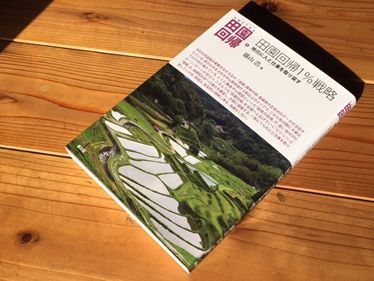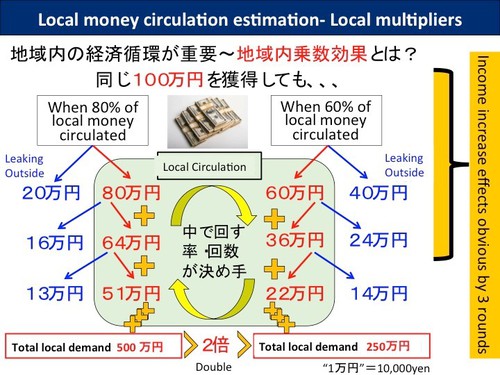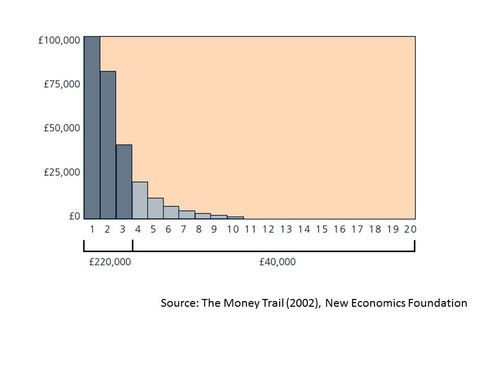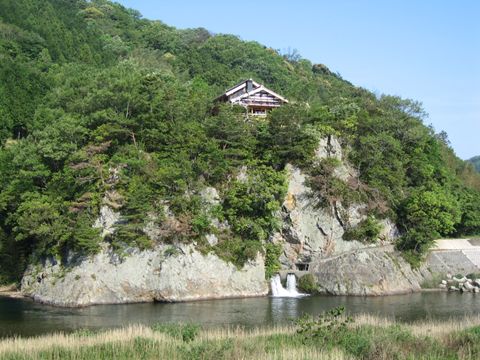January 11, 2016
Using the Circulation of Local Money to Recover the Economy and Population (Part 1): Featuring the 1% Rural Recovery Strategy and the 'Local Multiplier 3' Effect
Keywords: Civil Society / Local Issues Money Newsletter Steady-State Economy
JFS Newsletter No.160 (December 2015)

Copyright Shimane Prefectural Mountainous Region Research Center All Rights Reserved.
Japan for Sustainability (JFS) has been working on its Local Well-Being Project since April 2013, because we believe that local activities for well-being are the key to our happiness and planetary sustainability. This is because we believe that the state of the local economy is an indispensable issue to consider when looking closely at happiness and its relationship to local activities.
On October 26, 2015, an public lecture titled "A Local Strategy for Strengthening Local Money Circulation in Global Society" was held at the Tokyo Institute of Technology. In this issue and the next one, the JFS Newsletter introduces a summary of the lecture given by Dr. Ko Fujiyama, research producer of the Shimane Prefectural Mountainous Region Research Center.
The Primary Living Sphere as the 'Cell' of a Sustainable Society
I begin by presenting the research activities of the Shimane Prefectural Mountainous Region Research Center. Taking a multidisciplinary approach, the center functions as an integrated area study center of the mountainous areas of five prefectures in the Chugoku region, including Shimane where the center is located.
The theme of our research project is the evaluation of the local economic and social impacts of environmental policies and implementation of measures toward a low-carbon and recycling-oriented society operating in harmony with nature. The project is scheduled to run for three years, from FY2015 to FY2017.
It is good to promote activities for harmonious coexistence with the environment, but such actions have not actually made much progress at the local level. The first reason is lack of a sense of urgency. In rural areas, residents are more concerned about other critical issues, such as depopulation and securing their incomes, so environmental efforts need to be combined with these issues in order to move forward. The second reason is the lack of compelling explanations. It is essential to present effects in an easy-to-understand manner using assessment tools to ascertain the extent to which those environmental efforts would actually increase incomes and population levels at the local level. The third reason is a lack of integration, so we think we have to show the grand design of an integrated system toward creating a more sustainable and recycling-oriented society.
In designing such a sustainable system, our research focuses on the local residents' primary "living sphere" as a base unit, which is defined as an area that has fundamental public facilities, such as elementary and junior-high schools, a town/village office (branch), health clinic, and community hall. Japan's hilly and mountainous areas consist of approximately 10,000 sites of such primary living spheres, each with a population of about 1,500. We think each living sphere has to function as a cell of a sustainable society. To that end, we need to design an integrated, sustainable system considering all three elements of population, economy, and the environment within the primary area of local communities.
Restoring the Population by 1% Annually
In order to find a concrete prescription to achieve population stabilization amid the mounting sense of crisis over population decline nationwide, it is essential to investigate how many new residents we need to invite to rural areas every year. According to our population projection simulations using our own originally-developed program, if we could gain 1% more new residents each year out of the total population in the rural areas and have them settle there year by year, then the rural population would stabilize, population aging would be curbed, and the child population would also stabilize.
In fact, the number of new young residents has increased remarkably in the semi-mountainous areas in Shimane Prefecture since around 2010. Over one-third of the total 227 primary living spheres in Shimane have seen an increase in child population aged four years old and younger. Furthermore, an outstanding increase in the population is starting to be seen in the mountainous areas and remote islands. The population of women in their thirties, the child-rearing age, has also increased in over 40% of the semi-mountainous areas in the last five years. Signs of population stabilization are starting to be seen in about 5% of the areas in Shimane -- mostly mountainous areas and remote islands -- including the town of Ama, which is well-known for its vigorous strategies in town development.
Pursuing Local Economy and Well-Being in Ama Town, Shimane Prefecture
http://www.japanfs.org/en/news/archives/news_id034869.html
The total number of households and local residents necessary to stabilize the population in all the semi-mountainous areas in Shimane Prefecture is 1,251 households and 2,920 people, which accounts for 1% of the area population of 290,000. In short, population stabilization in the semi-mountainous areas in Shimane is achievable if we could add just one new resident per one hundred people every year. The number of 2,920 people necessary for population stabilization is about 0.01% out of 35.62 million -- the total population in the Tokyo Metropolitan Area.
Getting 1% Income Back
Not just focused on dealing with population issues, the 1% Rural Recovery Strategy also aims to achieve a one percent growth in income returning back to the local areas to support the local population. The strategy aims to promote the evolution of social systems that support and encourage a more sustainable society.

Copyright Shimane Prefectural Mountainous Region Research Center All Rights Reserved.
Through our research, we hope to realize an increase in local income large enough to sustain local residents, by strengthening the local circulation of money. In the past, basic needs for food and fuels were typically supplied within the local community, but the current rate of local procurement in these areas is not even 10%. If we could get this local procurement rate back up to 50%, then local production and consumption of nearly 200 million yen (U.S.$1.68 million) would be generated in a village with a population of 1,620.
Nowadays, for instance, large-scale wood biomass plants are sprouting up around the country, but we need to examine this situation to see if large plants like these will actually contribute to environmental protection and encourage residents to settle locally and earn an income. When constructing large plants or introducing high-performance and expensive equipment, most of the money invested and value created could leak out of the areas where the plants are located. At the same time, extensive logging to supply the plants could lead to environmental degradation.
Instead, real local income would be greater if people promoted small-scale cooperative forestry or manufactured and sold wood stoves locally among residents. Tools are needed to measure and compare impacts on the local economy, but no such analytic tools are available for use in small communities that have populations ranging from several hundred to several thousand people. One common approach is to make an input-output analysis region by region, but it is difficult for communities to make full use of this approach, because of the extensive time and cost required as well as level of expertise involved.
For this reason, new types of evaluation tool are needed for small municipalities. And these tools need to be linked with population forecasts, along with functions to analyze prospects of economic circulation improvements to encourage new residents to settle. In line with these ideas, we came upon the idea of utilizing the "Local Multiplier 3" (LM3), an analytic tool developed by the New Economics Foundation (NEF), a leading U.K. think-tank that promotes social, economic, and environmental justice. It facilitates the calculation of how much money is spent locally in the first three rounds of transactions.
Typically our attention is drawn to the scale of the initial investment and revenues, but it is important to consider how to ensure that the money gained does not leak out of the local economy, and instead, to have more of it circulate locally.
Taking a hypothetical case, imagine for example, that one small municipality gained one million yen (about $8,400). Now, compare the impact on local money circulation between 80% and 60% for the rate of local money recirculation . The area with 80% (80% of the million yen stays in the community and 20% leaks out) gains five million yen (about $42,000) locally in total, while the area with 60% (60% stays and 40% leaks out) gains 2.5 million yen (about $21,000) in total (Figure 1). This indicates that a mere 20% gap in the recirculation rate results in a two-fold difference in local demand in terms of local transactions.

Figure 1 Local Money Circulation
Copyright Shimane Prefectural Mountainous Region Research Center All Rights Reserved.
(To be continued in the next issue of the JFS Newsletter, January 2016.)
Edited by Naoko Niitsu and Junko Edahiro
Notes:
(1) Regarding the effects of local money circulation, please see JFS Newsletter No. 153, "JFS's Local Responsible Consumers Study Meetings."
(2) Local Multiplier 3 (LM3) is an analytic tool developed by the NEF to measure local multiplier effects in the economy of small communities. Under the scheme, the flow of money spent in the community or by local businesses is measured up to the third round.
Figure 2 indicates the money flow of a bed & breakfast, or B&B (accommodation facility), in England. As shown, about 85% of the initial income is kept locally in the third round. The B&B's annual income is 100,000 pounds. From the 100,000 pounds (first round), about 76,000 pounds is spent locally, which might, for example, include 50,000 pounds for wages and 26,000 pounds for local procurement of food and supplies. From the 76,000 pounds (second round), about 44,000 pounds is again spent locally (third round).

Figure 2 LM3 (Local Multiplier 3)
LM3 is calculated using the following formula: money from all three rounds together, divided by initial income. In this example, it is (100,000 + 76,000 + 44,000) / 100,000 = 2.2, which is the LM3 score. This score means that one pound gained locally makes contributions worth 2.2 pounds to the local economy. The bigger the LM3 score, the larger the impact on the local economy.

Copyright Shimane Prefectural Mountainous Region Research Center All Rights Reserved.
Related
"JFS Newsletter"
- 'Good Companies in Japan' (Article No.4): 'Eightfold Satisfaction' Management for Everyone's Happiness
- "Nai-Mono-Wa-Nai": Ama Town's Concept of Sufficiency and Message to the World
- 'Yumekaze' Wind Turbine Project Connects Metro Consumers and Regional Producers: Seikatsu Club Consumers' Co-operative
- Shaping Japan's Energy toward 2050 Participating in the Round Table for Studying Energy Situations
- 'Good Companies in Japan' (Article No.3): Seeking Ways to Develop Societal Contribution along with Core Businesses


